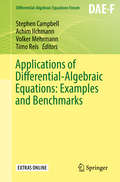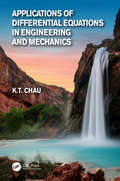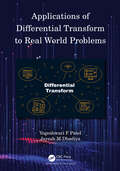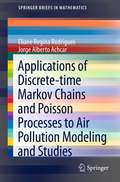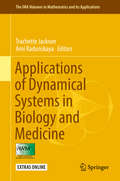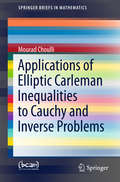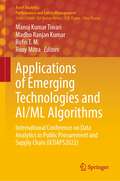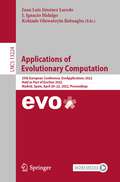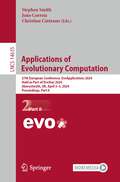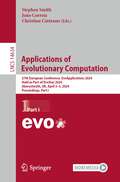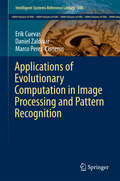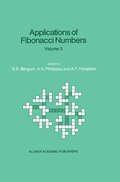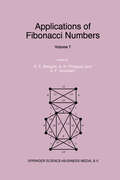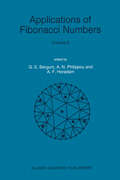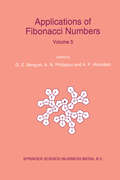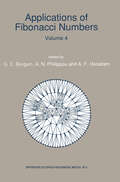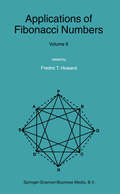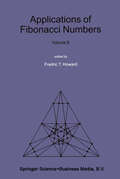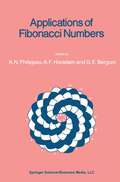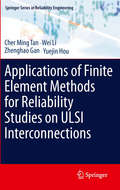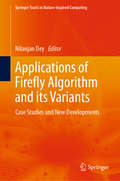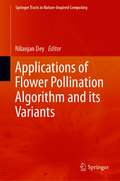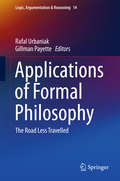- Table View
- List View
Applications of Differential-Algebraic Equations: Examples and Benchmarks (Differential-Algebraic Equations Forum)
by Stephen Campbell Achim Ilchmann Volker Mehrmann Timo ReisThis volume encompasses prototypical, innovative and emerging examples and benchmarks of Differential-Algebraic Equations (DAEs) and their applications, such as electrical networks, chemical reactors, multibody systems, and multiphysics models, to name but a few. Each article begins with an exposition of modelling, explaining whether the model is prototypical and for which applications it is used. This is followed by a mathematical analysis, and if appropriate, a discussion of the numerical aspects including simulation. Additionally, benchmark examples are included throughout the text.Mathematicians, engineers, and other scientists, working in both academia and industry either on differential-algebraic equations and systems or on problems where the tools and insight provided by differential-algebraic equations could be useful, would find this book resourceful.
Applications of Differential Equations in Engineering and Mechanics
by Kam Tim ChauThis second of two comprehensive reference texts on differential equations continues coverage of the essential material students they are likely to encounter in solving engineering and mechanics problems across the field - alongside a preliminary volume on theory. This book covers a very broad range of problems, including beams and columns, plates, shells, structural dynamics, catenary and cable suspension bridge, nonlinear buckling, transports and waves in fluids, geophysical fluid flows, nonlinear waves and solitons, Maxwell equations, Schrodinger equations, celestial mechanics and fracture mechanics and dynamics. The focus is on the mathematical technique for solving the differential equations involved. All readers who are concerned with and interested in engineering mechanics problems, climate change, and nanotechnology will find topics covered in this book providing valuable information and mathematics background for their multi-disciplinary research and education.
Applications of Differential Equations in Engineering and Mechanics
by Kam Tim ChauThis second of two comprehensive reference texts on differential equations continues coverage of the essential material students they are likely to encounter in solving engineering and mechanics problems across the field - alongside a preliminary volume on theory. This book covers a very broad range of problems, including beams and columns, plates, shells, structural dynamics, catenary and cable suspension bridge, nonlinear buckling, transports and waves in fluids, geophysical fluid flows, nonlinear waves and solitons, Maxwell equations, Schrodinger equations, celestial mechanics and fracture mechanics and dynamics. The focus is on the mathematical technique for solving the differential equations involved. All readers who are concerned with and interested in engineering mechanics problems, climate change, and nanotechnology will find topics covered in this book providing valuable information and mathematics background for their multi-disciplinary research and education.
Applications of Differential Transform to Real World Problems
by Yogeshwari F Patel Jayesh M DhodiyaThis book is an invaluable resource for applied researchers to find the analytical solution of differential equations describing the dynamical system with less computational effort and time. It describes the basic concepts of the differential transform method and solution of various real-world problems described by simple to complicated differential equations. It provides a computational technique that is not only conceptually simple and easy to use but also readily adaptable for computer coding. Different chapters of the book deal with the basic differential equations involved in the physical phenomena as well as a complicated system of differential equations described by the mathematical model.The book offers comprehensive coverage of the most essential topics, including Basic concepts and fundamental properties of the proposed technique with proof The solution of linear, nonlinear, homogeneous, and nonhomogeneous ordinary differential equations (ODEs) and partial differential equations (PDEs) The initial and boundary value problems Real-world ODE and PDE problems are also discussed Applications of Differential Transform to Real World Problems is primarily aimed at undergraduates, graduates, and researchers studying differential equations. Scientists dealing with complicated differential equations or systems of differential equations will also find this book useful.
Applications of Differential Transform to Real World Problems
by Yogeshwari F Patel Jayesh M DhodiyaThis book is an invaluable resource for applied researchers to find the analytical solution of differential equations describing the dynamical system with less computational effort and time. It describes the basic concepts of the differential transform method and solution of various real-world problems described by simple to complicated differential equations. It provides a computational technique that is not only conceptually simple and easy to use but also readily adaptable for computer coding. Different chapters of the book deal with the basic differential equations involved in the physical phenomena as well as a complicated system of differential equations described by the mathematical model.The book offers comprehensive coverage of the most essential topics, including Basic concepts and fundamental properties of the proposed technique with proof The solution of linear, nonlinear, homogeneous, and nonhomogeneous ordinary differential equations (ODEs) and partial differential equations (PDEs) The initial and boundary value problems Real-world ODE and PDE problems are also discussed Applications of Differential Transform to Real World Problems is primarily aimed at undergraduates, graduates, and researchers studying differential equations. Scientists dealing with complicated differential equations or systems of differential equations will also find this book useful.
Applications of Discrete-time Markov Chains and Poisson Processes to Air Pollution Modeling and Studies (SpringerBriefs in Mathematics)
by Eliane Regina Rodrigues Jorge Alberto AchcarIn this brief we consider some stochastic models that may be used to study problems related to environmental matters, in particular, air pollution. The impact of exposure to air pollutants on people's health is a very clear and well documented subject. Therefore, it is very important to obtain ways to predict or explain the behaviour of pollutants in general. Depending on the type of question that one is interested in answering, there are several of ways studying that problem. Among them we may quote, analysis of the time series of the pollutants' measurements, analysis of the information obtained directly from the data, for instance, daily, weekly or monthly averages and standard deviations. Another way to study the behaviour of pollutants in general is through mathematical models. In the mathematical framework we may have for instance deterministic or stochastic models. The type of models that we are going to consider in this brief are the stochastic ones.
Applications of Dynamical Systems in Biology and Medicine (The IMA Volumes in Mathematics and its Applications #158)
by Trachette Jackson Ami RadunskayaThis volume highlights problems from a range of biological and medical applications that can be interpreted as questions about system behavior or control. Topics include drug resistance in cancer and malaria, biological fluid dynamics, auto-regulation in the kidney, anti-coagulation therapy, evolutionary diversification and photo-transduction. Mathematical techniques used to describe and investigate these biological and medical problems include ordinary, partial and stochastic differentiation equations, hybrid discrete-continuous approaches, as well as 2 and 3D numerical simulation.
Applications of Elliptic Carleman Inequalities to Cauchy and Inverse Problems (SpringerBriefs in Mathematics)
by Mourad ChoulliThis book presents a unified approach to studying the stability of both elliptic Cauchy problems and selected inverse problems. Based on elementary Carleman inequalities, it establishes three-ball inequalities, which are the key to deriving logarithmic stability estimates for elliptic Cauchy problems and are also useful in proving stability estimates for certain elliptic inverse problems. The book presents three inverse problems, the first of which consists in determining the surface impedance of an obstacle from the far field pattern. The second problem investigates the detection of corrosion by electric measurement, while the third concerns the determination of an attenuation coefficient from internal data, which is motivated by a problem encountered in biomedical imaging.
Applications of Emerging Technologies and AI/ML Algorithms: International Conference on Data Analytics in Public Procurement and Supply Chain (ICDAPS2022) (Asset Analytics)
by Manoj Kumar Tiwari Madhu Ranjan Kumar Rofin T. M. Rony MitraThis book provides practical insights into applications of the state-of-the-art of Machine Learning and Artificial Intelligence (AI) for solving intriguing and complex problems in procurement and supply chain management. The application domain includes perishable food supply chain, steel price prediction, electric vehicle charging infrastructure design, contract price negotiation, reverse logistics network design, and demand forecasting. Further, the book highlights the advanced topics in the procurement field, like AI in green procurement and e-procurement in the pharma sector. Furthermore, the book covers applications of well-established methodologies such as heuristics, optimization, game theory, and MCDM based on the nature of the problem. The inclusion of the vaccine supply chain digital twin and blockchain-based procurement signals the significance of the book. This book is a comprehensive guide for industry professionals to understand the power of data analytics, enabling them to improve efficiency and effectiveness in the procurement and supply chain sectors.
Applications of Evolutionary Computation: 25th European Conference, EvoApplications 2022, Held as Part of EvoStar 2022, Madrid, Spain, April 20–22, 2022, Proceedings (Lecture Notes in Computer Science #13224)
by Juan Luis Jiménez Laredo J. Ignacio Hidalgo Kehinde Oluwatoyin BabaagbaThis book constitutes the refereed proceedings of the 25th International Conference on Applications of Evolutionary Computation, EvoApplications 2022, held as part of Evo*2022, in April 2022, co-located with the Evo*2022 events EuroGP, EvoCOP, and EvoMUSART. The 46 revised full papers presented in this book were carefully reviewed and selected from 67 submissions.
Applications of Evolutionary Computation: 27th European Conference, EvoApplications 2024, Held as Part of EvoStar 2024, Aberystwyth, UK, April 3–5, 2024, Proceedings, Part II (Lecture Notes in Computer Science #14635)
by Stephen Smith João Correia Christian CintranoThe two-volume set LNCS 14634 and 14635 constitutes the refereed proceedings of the 27th European Conference on Applications of Evolutionary Computation, EvoApplications 2024, held as part of EvoStar 2024, in Aberystwyth, UK, April 3–5, 2024, and co-located with the EvoStar events, EvoCOP, EvoMUSART, and EuroGP.The 51 full papers presented in these proceedings were carefully reviewed and selected from 77 submissions. The papers have been organized in the following topical sections: applications of evolutionary computation; analysis of evolutionary computation methods: theory, empirics, and real-world applications; computational intelligence for sustainability; evolutionary computation in edge, fog, and cloud computing; evolutionary computation in image analysis, signal processing and pattern recognition; evolutionary machine learning; machine learning and AI in digital healthcare and personalized medicine; problem landscape analysis for efficient optimization; softcomputing applied to games; and surrogate-assisted evolutionary optimisation.
Applications of Evolutionary Computation: 27th European Conference, EvoApplications 2024, Held as Part of EvoStar 2024, Aberystwyth, UK, April 3–5, 2024, Proceedings, Part I (Lecture Notes in Computer Science #14634)
by Stephen Smith João Correia Christian CintranoThe two-volume set LNCS 14634 and 14635 constitutes the refereed proceedings of the 27th European Conference on Applications of Evolutionary Computation, EvoApplications 2024, held as part of EvoStar 2024, in Aberystwyth, UK, April 3–5, 2024, and co-located with the EvoStar events, EvoCOP, EvoMUSART, and EuroGP.The 51 full papers presented in these proceedings were carefully reviewed and selected from 77 submissions. The papers have been organized in the following topical sections: applications of evolutionary computation; analysis of evolutionary computation methods: theory, empirics, and real-world applications; computational intelligence for sustainability; evolutionary computation in edge, fog, and cloud computing; evolutionary computation in image analysis, signal processing and pattern recognition; evolutionary machine learning; machine learning and AI in digital healthcare and personalized medicine; problem landscape analysis for efficient optimization; softcomputing applied to games; and surrogate-assisted evolutionary optimisation.
Applications of Evolutionary Computation in Image Processing and Pattern Recognition (Intelligent Systems Reference Library #100)
by Erik Cuevas Daniel Zaldívar Marco Perez-CisnerosThis book presents the use of efficient Evolutionary Computation (EC) algorithms for solving diverse real-world image processing and pattern recognition problems. It provides an overview of the different aspects of evolutionary methods in order to enable the reader in reaching a global understanding of the field and, in conducting studies on specific evolutionary techniques that are related to applications in image processing and pattern recognition. It explains the basic ideas of the proposed applications in a way that can also be understood by readers outside of the field. Image processing and pattern recognition practitioners who are not evolutionary computation researchers will appreciate the discussed techniques beyond simple theoretical tools since they have been adapted to solve significant problems that commonly arise on such areas. On the other hand, members of the evolutionary computation community can learn the way in which image processing and pattern recognition problems can be translated into an optimization task. The book has been structured so that each chapter can be read independently from the others. It can serve as reference book for students and researchers with basic knowledge in image processing and EC methods.
Applications of Fibonacci Numbers: Volume 3 Proceedings of ‘The Third International Conference on Fibonacci Numbers and Their Applications’, Pisa, Italy, July 25–29, 1988
by G. E. Bergum Andreas N. Philippou Alwyn F. HoradamThis book contains thirty-six papers from among the forty-five papers presented at the Third International Conference on Fibonacci Numbers and Their Applications which was held in Pisa, Italy from July 25 to July 29, 1988 in honor of Leonardo de Pisa. These papers have been selected after a careful review by well known referees in the field, and they range from elementary number theory to probability and statistics. The Fibonacci numbers are their unifying bond. It is anticipated that this book, like its two predecessors, will be useful to research workers and graduate students interested in the Fibonacci numbers and their applications. August 1989 The Editors Gerald E. Bergum South Dakota State University Brookings, South Dakota, U. S. A. Andreas N. Philippou Ministry of Education Nicosia, Cyprus Alwyn F. Horadam University of New England Armidale N. S. W. , Australia xv THE ORGANIZING COMMITTEES LOCAL COMMITTEE INTERNATIONAL COMMITTEE Dvornicich, Roberto, Chairman Horadam, A. F. (Australia), Co-chairman Filipponi, Piero Philippou, A. N. (Cyprus), Co-chairman Perelli, Alberto Ando, S. (Japan) Viola, Carlo Bergum, G. E. (U. S. A. ) Zannier, Umberto Johnson, M. B. (U. S. A. ) Kiss, P. (Hungary) Tijdeman, Robert (The Netherlands) Tognetti, K. (Australia) XVII LIST OF CONTRIBUTORS TO THE CONFERENCE' ADLER, I. , RR 1, Box 532, North Bennington, VT 05257-9748. "Separating the Biological from the Mathematical Aspects of Phyllotaxis. " *AKRITAS, A. G. , (coauthor P. G. Bradford). "The Role of the Fibonacci Sequence in the Isolation of the Real Roots of Polynomial Equations.
Applications of Fibonacci Numbers: Volume 7
by G. E. Bergum Andreas N. Philippou Alwyn F. HoradamProceedings of `The Seventh International Research Conference on Fibonacci Numbers and Their Applications', Technische Universität, Graz, Austria, July 15-19, 1996
Applications of Fibonacci Numbers: Volume 6 Proceedings of ‘The Sixth International Research Conference on Fibonacci Numbers and Their Applications’, Washington State University, Pullman, Washington, U.S.A., July 18-22, 1994
by G. E. Bergum Andreas N. Philippou Alwyn F. HoradamThis book contains 43 papers form among the 55 papers presented at the Sixth International Conference on Fibonacci Numbers and Their Applications which was held at Washington State University, Pullman, Washington, from July 18-22, 1994. These papers have been selected after a careful review by well known referees in the field, and they range from elementary number theory to probability and statistics. The Fibonacci numbers and recurrence relations are their unifying bond. It is anticipated that this book, like its five predecessors, will be useful to research workers and graduate students interested in the Fibonacci numbers and their applications. October 30, 1995 The Editors Gerald E. Bergum South Dakota State University Brookings, South Dakota, U.S.A. Alwyn F. Horadam University of New England Armidale, N.S.W., Australia Andreas N. Philippou 26 Atlantis Street Aglangia, Nicosia Cyprus xxi THE ORGANIZING COMMITTEES LOCAL COMMITTEE INTERNATIONAL COMMITTEE Long, Calvin T., Co-Chair Horadam, A.F. (Australia), Co-Chair Webb, William A., Co-Chair Philippou, A.N. (Cyprus), Co-Chair Burke, John Ando, S. (Japan) DeTemple, Duane W.
Applications of Fibonacci Numbers: Proceedings of ‘The Fifth International Conference on Fibonacci Numbers and Their Applications’, The University of St. Andrews, Scotland, July 20—July 24, 1992
by G. E. Bergum Andreas N. Philippou Alwyn F. HoradamThis book contains 58 papers from among the 68 papers presented at the Fifth International Conference on Fibonacci Numbers and Their Applications which was held at the University of St. Andrews, St. Andrews, Fife, Scotland from July 20 to July 24, 1992. These papers have been selected after a careful review by well known referees in the field, and they range from elementary number theory to probability and statistics. The Fibonacci numbers and recurrence relations are their unifying bond. It is anticipated that this book, like its four predecessors, will be useful to research workers and graduate students interested in the Fibonacci numbers and their applications. June 5, 1993 The Editors Gerald E. Bergum South Dakota State University Brookings, South Dakota, U.S.A. Alwyn F. Horadam University of New England Armidale, N.S.W., Australia Andreas N. Philippou Government House Z50 Nicosia, Cyprus xxv THE ORGANIZING COMMITTEES LOCAL COMMITTEE INTERNATIONAL COMMITTEE Campbell, Colin M., Co-Chair Horadam, A.F. (Australia), Co-Chair Phillips, George M., Co-Chair Philippou, A.N. (Cyprus), Co-Chair Foster, Dorothy M.E. Ando, S. (Japan) McCabe, John H. Bergum, G.E. (U.S.A.) Filipponi, P. (Italy) O'Connor, John J.
Applications of Fibonacci Numbers: Volume 4 Proceedings of ‘The Fourth International Conference on Fibonacci Numbers and Their Applications’, Wake Forest University, N.C., U.S.A., July 30–August 3, 1990
by G. E. Bergum Andreas N. Philippou Alwyn F. HoradamThis book contains thirty-three papers from among the thirty-eight papers presented at the Fourth International Conference on Fibonacci Numbers and Their Applications which was held at Wake Forest University, Winston-Salem, North Carolina from July 30 to August 3, 1990. These papers have been selected after a careful review by well known referees in the field, and they range from elementary number theory to probability and statistics. The Fibonacci numbers and recurrence relations are their unifying bond. It is anticipated that this book, like its three predecessors, will be useful to research workers and graduate students interested in the Fibonacci numbers and their applications. March 1, 1991 The Editors Gerald E. Bergum South Dakota State University Brookings, South Dakota, U. S. A. Alwyn F. Horadam University of New England Armidale, N. S. W. , Australia Andreas N. Philippou Minister of Education Ministry of Education Nicosia, Cyprus xv THE ORGANIZING COMMITTEES LOCAL COMMITTEE INTERNATIONAL COMMITTEE Howard, Fred T. , Co-Chair Horadam, A. F. (Australia), Co-Chair Waddill, Marcellus E. , Co-Chair Philippou, A. N. (Cyprus), Co-Chair Hayashi, Elmer K. Ando, S. (Japan) Bergum, G. E. (U. S. A. ) Vaughan, Theresa Harrell, Deborah Bicknell-Johnson, M. B. (U. S. A. ) Campbell, Colin (Scotland) Filipponi, Piero (Italy) Kiss, P. (Hungary) Turner, J. C. (New Zealand) xvii LIST OF CONTRIBUTORS TO THE CONFERENCE *ALFORD, CECIL 0. , (coauthor Daniel C. Fielder) "Pascal's Triangle: Top Gun or Just One of the Gang?" *ANDERSON, PETER G. , "A Fibonacci-Based Pseudo-Random Number Generator.
Applications of Fibonacci Numbers: Volume 9: Proceedings of The Tenth International Research Conference on Fibonacci Numbers and Their Applications
by Fredric T. HowardThis book contains 28 research articles from among the 49 papers and abstracts presented at the Tenth International Conference on Fibonacci Numbers and Their Applications. These articles have been selected after a careful review by expert referees, and they range over many areas of mathematics. The Fibonacci numbers and recurrence relations are their unifying bond. We note that the article "Fibonacci, Vern and Dan" , which follows the Introduction to this volume, is not a research paper. It is a personal reminiscence by Marjorie Bicknell-Johnson, a longtime member of the Fibonacci Association. The editor believes it will be of interest to all readers. It is anticipated that this book, like the eight predecessors, will be useful to research workers and students at all levels who are interested in the Fibonacci numbers and their applications. March 16, 2003 The Editor Fredric T. Howard Mathematics Department Wake Forest University Box 7388 Reynolda Station Winston-Salem, NC 27109 xxi THE ORGANIZING COMMITTEES LOCAL COMMITTEE INTERNATIONAL COMMITTEE Calvin Long, Chairman A. F. Horadam (Australia), Co-Chair Terry Crites A. N. Philippou (Cyprus), Co-Chair Steven Wilson A. Adelberg (U. S. A. ) C. Cooper (U. S. A. ) Jeff Rushal H. Harborth (Germany) Y. Horibe (Japan) M. Bicknell-Johnson (U. S. A. ) P. Kiss (Hungary) J. Lahr (Luxembourg) G. M. Phillips (Scotland) J. 'Thrner (New Zealand) xxiii xxiv LIST OF CONTRlBUTORS TO THE CONFERENCE * ADELBERG, ARNOLD, "Universal Bernoulli Polynomials and p-adic Congruences. " *AGRATINI, OCTAVIAN, "A Generalization of Durrmeyer-Type Polynomials. " BENJAMIN, ART, "Mathemagics.
Applications of Fibonacci Numbers: Volume 8: Proceedings of The Eighth International Research Conference on Fibonacci Numbers and Their Applications
by Fredric T. HowardThis book contains 33 papers from among the 41 papers presented at the Eighth International Conference on Fibonacci Numbers and Their Applications which was held at the Rochester Institute of Technology, Rochester, New York, from June 22 to June 26, 1998. These papers have been selected after a careful review by well known referees in the field, and they range from elementary number theory to probability and statistics. The Fibonacci numbers and recurrence relations are their unifying bond. It is anticipated that this book, like its seven predecessors, will be useful to research workers and graduate students interested in the Fibonacci numbers and their applications. June 1, 1999 The Editor F. T. Howard Mathematics and Computer Science Wake Forest University Box 7388 Reynolda Station Winston-Salem, NC USA xvii THE ORGANIZING COMMITTEES LOCAL COMMITTEE INTERNATIONAL COMMITTEE Anderson, Peter G. , Chairman Horadam, A. F. (Australia), Co-Chair Arpaya, Pasqual Philippou, A. N. (Cyprus), Co-Chair Biles, John Bergum, G. E. (U. S. A. ) Orr, Richard Filipponi, P. (Italy) Radziszowski, Stanislaw Harborth, H. (Germany) Rich, Nelson Horibe, Y. (Japan) Howard, F. (U. S. A. ) Johnson, M. (U. S. A. ) Kiss, P. (Hungary) Phillips, G. M. (Scotland) Turner, J. (New Zealand) Waddill, M. E. (U. S. A. ) xix LIST OF CONTRIBUTORS TO THE CONFERENCE AGRATINI, OCTAVIAN, "Unusual Equations in Study. " *ANDO, SHIRO, (coauthor Daihachiro Sato), "On the Generalized Binomial Coefficients Defined by Strong Divisibility Sequences. " *ANATASSOVA, VASSIA K. , (coauthor J. C.
Applications of Fibonacci Numbers: Volume 2
by Andreas N. Philippou Alwyn F. Horadam G. E. BergumThis book contains nineteen papers from among the twenty-five papers presented at the Second International Conference on Fibonacci Numbers and Their Applications. These papers have been selected after a careful review by well known referee's in the field, and they range from elementary number theory to probability and statistics. The Fibonacci numbers are their unifying bond. It is anticipated that this book will be useful to research workers and graduate students interested in the Fibonacci numbers and their applications. October 1987 The Editors Gerald E. Bergum South Dakota State University Brookings, South Dakota, U.S.A. Andreas N. Philippou University of Patras Patras, Greece Alwyn F. Horadam University of New England Armidale, N.S.W., Australia xiii THE ORGANIZING COMMITTEES LOCAL COMMITTEE INTERN A TIONAL COMMITTEE Bergum, G., Chairman Philippou, A. (Greece), Chairman Edgar, H., Co-chalrman Horadam, A. (Australia), Co-chalrman Bergum, G. (U.s.A.) Thoro, D. Kiss, P. (Hungary) Johnson, M. Long, C. (U.S.A.) Lange, L.
Applications of Finite Element Methods for Reliability Studies on ULSI Interconnections (Springer Series in Reliability Engineering)
by Cher Ming Tan Wei Li Zhenghao Gan Yuejin HouApplications of Finite Element Methods for Reliability Studies on ULSI Interconnections provides a detailed description of the application of finite element methods (FEMs) to the study of ULSI interconnect reliability. Over the past two decades the application of FEMs has become widespread and continues to lead to a much better understanding of reliability physics.To help readers cope with the increasing sophistication of FEMs’ applications to interconnect reliability, Applications of Finite Element Methods for Reliability Studies on ULSI Interconnections will:introduce the principle of FEMs;review numerical modeling of ULSI interconnect reliability;describe the physical mechanism of ULSI interconnect reliability encountered in the electronics industry; anddiscuss in detail the use of FEMs to understand and improve ULSI interconnect reliability from both the physical and practical perspective, incorporating the Monte Carlo method.A full-scale review of the numerical modeling methodology used in the study of interconnect reliability highlights useful and noteworthy techniques that have been developed recently. Many illustrations are used throughout the book to improve the reader’s understanding of the methodology and its verification. Actual experimental results and micrographs on ULSI interconnects are also included.Applications of Finite Element Methods for Reliability Studies on ULSI Interconnections is a good reference for researchers who are working on interconnect reliability modeling, as well as for those who want to know more about FEMs for reliability applications. It gives readers a thorough understanding of the applications of FEM to reliability modeling and an appreciation of the strengths and weaknesses of various numerical models for interconnect reliability.
Applications of Firefly Algorithm and its Variants: Case Studies and New Developments (Springer Tracts in Nature-Inspired Computing)
by Nilanjan DeyThe book discusses advantages of the firefly algorithm over other well-known metaheuristic algorithms in various engineering studies. The book provides a brief outline of various application-oriented problem solving methods, like economic emission load dispatch problem, designing a fully digital controlled reconfigurable switched beam nonconcentric ring array antenna, image segmentation, span minimization in permutation flow shop scheduling, multi-objective load dispatch problems, image compression, etc., using FA and its variants. It also covers the use of the firefly algorithm to select features, as research has shown that the firefly algorithm generates precise and optimal results in terms of time and optimality. In addition, the book also explores the potential of the firefly algorithm to provide a solution to traveling salesman problem, graph coloring problem, etc
Applications of Flower Pollination Algorithm and its Variants (Springer Tracts in Nature-Inspired Computing)
by Nilanjan DeyThis book presents essential concepts of traditional Flower Pollination Algorithm (FPA) and its recent variants and also its application to find optimal solution for a variety of real-world engineering and medical problems. Swarm intelligence-based meta-heuristic algorithms are extensively implemented to solve a variety of real-world optimization problems due to its adaptability and robustness. FPA is one of the most successful swarm intelligence procedures developed in 2012 and extensively used in various optimization tasks for more than a decade. The mathematical model of FPA is quite straightforward and easy to understand and enhance, compared to other swarm approaches. Hence, FPA has attracted attention of researchers, who are working to find the optimal solutions in variety of domains, such as N-dimensional numerical optimization, constrained/unconstrained optimization, and linear/nonlinear optimization problems. Along with the traditional bat algorithm, the enhanced versions of FPA are also considered to solve a variety of optimization problems in science, engineering, and medical applications.
Applications of Formal Philosophy: The Road Less Travelled (Logic, Argumentation & Reasoning #14)
by Rafał Urbaniak Gillman PayetteThis book features mathematical and formal philosophers’ efforts to understand philosophical questions using mathematical techniques. It offers a collection of works from leading researchers in the area, who discuss some of the most fascinating ways formal methods are now being applied. It covers topics such as: the uses of probable and statistical reasoning, rational choice theory, reasoning in the environmental sciences, reasoning about laws and changes of rules, and reasoning about collective decision procedures as well as about action. Utilizing mathematical techniques has been very fruitful in the traditional domains of formal philosophy – logic, philosophy of mathematics and metaphysics – while formal philosophy is simultaneously branching out into other areas in philosophy and the social sciences. These areas particularly include ethics, political science, and the methodology of the natural and social sciences. Reasoning about legal rules, collective decision-making procedures, and rational choices are of interest to all those engaged in legal theory, political science and economics. Statistical reasoning is also of interest to political scientists and economists.
